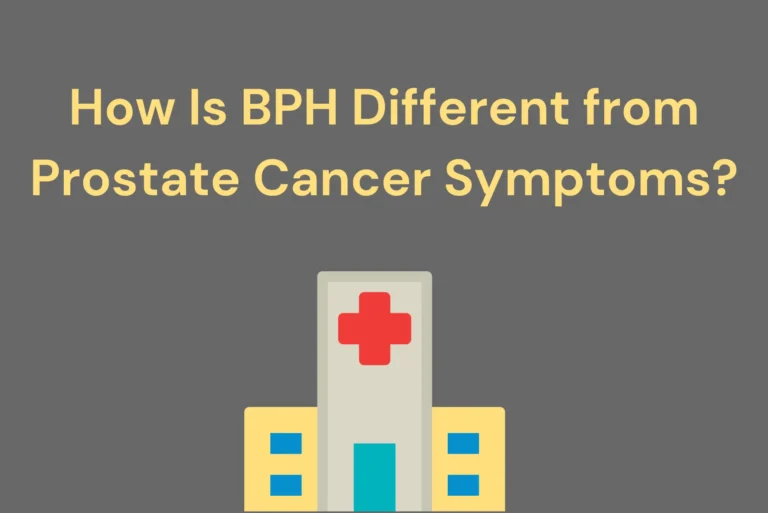Benign Prostatic Hyperplasia (BPH) and prostate cancer are two common conditions affecting men, particularly as they age. While both conditions involve the prostate gland and share some overlapping symptoms, they have distinct causes, risks, and treatments. Understanding the differences between these conditions is essential for early diagnosis and effective management.
Understanding BPH and Prostate Cancer
BPH is a non-cancerous enlargement of the prostate that affects urinary function. It occurs when the prostate gland grows in size, often leading to discomfort and frequent urination. Prostate cancer, on the other hand, is the uncontrolled growth of abnormal cells in the prostate, which can spread to other parts of the body if left untreated. Although both conditions are linked to aging, their causes and health implications are significantly different.
Key Differences Between BPH and Prostate Cancer Symptoms
Urinary Symptoms and Their Variations
One of the primary concerns for men experiencing prostate-related issues is urinary symptoms. Both BPH and prostate cancer can cause problems with urination, but there are some notable distinctions.
- BPH Symptoms: Men with BPH often experience a weak urine stream, frequent urination (especially at night), and difficulty starting or stopping urination. While bothersome, these symptoms do not indicate cancer.
- Prostate Cancer Symptoms: Prostate cancer can also affect urination, but it may include additional signs such as blood in the urine or semen, unexplained weight loss, and persistent pain in the pelvic area.
For more details on Hyperplasia Symptoms, it is advisable to consult reliable health sources to understand the early signs of BPH.
Pain and Discomfort Levels
Men with BPH may experience discomfort due to the pressure of an enlarged prostate on the bladder and urethra, but it is rarely painful. In contrast, prostate cancer may cause persistent pain in the lower back, hips, or pelvis. This pain is often an indication that cancer has spread beyond the prostate gland.
Risk Factors and Causes
Causes of BPH
The exact cause of BPH is not fully understood, but it is linked to age-related hormonal changes. As men age, the levels of testosterone and estrogen in the body fluctuate, leading to an overgrowth of prostate cells.
Causes of Prostate Cancer
Prostate cancer, however, results from genetic mutations that cause abnormal cell growth in the prostate. Risk factors include family history, high-fat diets, obesity, and exposure to certain chemicals.
Diagnostic Methods
Diagnosing BPH
Doctors diagnose BPH through physical exams, urine tests, and imaging scans. A common diagnostic tool is the digital rectal exam (DRE), which helps determine prostate size.
Diagnosing Prostate Cancer
Prostate cancer diagnosis typically involves a Prostate-Specific Antigen (PSA) test, biopsy, and MRI scans. A high PSA level may indicate prostate cancer, but further tests are necessary for confirmation.
Treatment Options for BPH and Prostate Cancer
BPH Treatment
BPH treatment focuses on symptom relief. Lifestyle modifications, medications, and minimally invasive procedures like laser therapy can help manage the condition. In severe cases, surgery may be recommended.
Prostate Cancer Treatment
Prostate cancer treatment depends on the stage of the disease. Options include active surveillance, radiation therapy, hormone therapy, surgery, and chemotherapy. Early detection plays a crucial role in successful treatment outcomes.
For more insights on BPH Signs and Symptoms and how to differentiate them from serious conditions, medical experts recommend regular check-ups.
Preventive Measures for Prostate Health
Diet and Nutrition
Maintaining a healthy diet can lower the risk of both BPH and prostate cancer. A diet rich in fruits, vegetables, and lean proteins supports prostate health. Avoiding excessive red meat and processed foods is also beneficial.
Regular Exercise
Physical activity improves circulation, reduces inflammation, and promotes hormonal balance. Exercises such as walking, cycling, and yoga are particularly beneficial for prostate health.
Routine Check-Ups
Regular prostate screenings help detect abnormalities early, allowing for timely intervention. Men over 50 should undergo PSA tests and DRE exams as part of their routine health check-ups.
Choosing the Right Medical Support
Selecting the right healthcare provider for prostate issues is crucial. Consider specialists who have experience in urology and prostate care. Look for clinics that offer advanced diagnostic tools and a range of treatment options tailored to individual needs.
For additional insights into maintaining optimal health, visit Inner Beauty. Discover expert advice on holistic wellness, nutrition, and fitness to support overall well-being.








